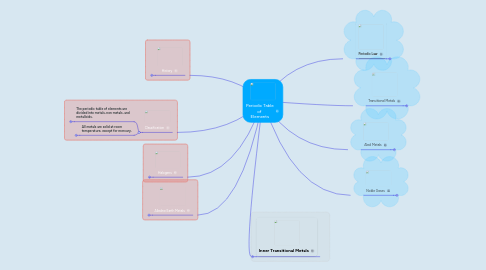Periodic Table of Elements
por Michael Reed


1. Halogens
1.1. Halogens are nonmetal. At room temperature fluorine and chlorine are gases and bromine is a liquid.
1.2. They are group 7A
1.3. All of the halogens have been observed to react with hydrogen to form hydrogen halides.
2. Inner Transitional Metals
2.1. Mostly laboratory prepared elements that do no occur in nature
2.2. They are the two bottom rows on the periodic table or f group
2.3. The inner Transitional metals can be divided by lanthanides and actinides. Actinides are very radioactive
3. History
3.1. Dmitri Mendeleev arranged the elements in his periodic table in order of increasing atomic mass
3.2. J.W Dobereniner published a classification system where the elements were organized into tirads, or three elements with similar properties
3.2.1. In the modern periodic table, the elements are arranged in order of increasing atomic number
4. Alkaline Earth Metals
4.1. Most alkaline metals are relatively soft, but harder than Alkali Metals.
4.1.1. They are also Group 2A
4.2. Alkaline Earth metals react with oxygen to form vinary Oxides.
5. Classification
5.1. The periodic table of elements are divided into metals, non metals, and metalloids.
5.1.1. Metals are generally good conductors of heat and electric current.
5.1.2. Mon metals are poor conductors of heat and electric currents.
5.1.3. <etallpods generally have properties that ae similar to those of metals and non metals.
5.2. All metals are solid at room temperature, except for mercury.
5.2.1. Most non metals are gases at room temperature. A few are solids such as sulfur, and phosphorus.
5.2.2. Metalloids can act like either a metal or a nonmetal. Usually can be controlled by changing the temperature .
6. Periodic Law
6.1. When elements are arranged in order of increasing atomic number, there is a periodic repetition of their physical and chemical properties .
6.2. The first two elements are both in a gas form as well as they're very light as well as they're both nonmetals
7. Akali Metals
7.1. They are silver-gray solids that are soft enough to cut with a knife.
7.1.1. They are soft because they only have one valence electron
7.2. They can be found in group 1A
7.3. All Alkali metals react with Halogens to form an ionic halide.
8. Transitional Metals
8.1. Most are ductile, malleable, and good conductors of heat and electri current
8.1.1. Most transition metals form compounds with distinctive colors.
